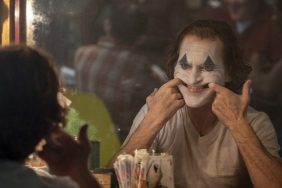The name “Alan Smithee” is well known to many film buffs. It is the pseudonym selected by film directors who, usually upset with studio-enforced tampering on their films, decide to remove their name from the film’s credits. In most cases, the directors remove their name after viewing a damning edit, or are surprised to learn that other directors have been assigned to insert new footage without their consent. Or, and this is unfortunately common in Hollywood, the process of making the film becomes a long list of compromises and wresting of creative control, and the director, once hopeful and strong in the creative process, becomes increasingly relegated to the side, to the point that they are no longer in charge.
Very occasionally, though, a director will become so disillusioned by the filmmaking process that they will simply pull up stakes and leave the production altogether. This reportedlly happened on the set of the new in-production Judge Dredd film, which had gotten as far as the post-production process. Director Pete Travis, due to “creative differences” supposedly left the set of movie, and was replaced, partway through, by the screenwriter, Alex Garland. I look forward to seeing who will ultimately receive credit. [Update: The director and writer of Dredd have since issued a statement that the rumors weren’t true, and that Travis is still involved.]
This is an unfortunate, but deliciously scandalous facet of Hollywood filmmaking – directors leaving a production before completion – and, as such, warrants the following list to consider. Here are just some of the notable instances when a director, incensed and offended, left the set the movie they were working on.
Arthur Hiller on AN ALAN SMITHEE FILM: BURN, HOLLYWOOD, BURN (1998)

Arthur Hiller is a workmanlike director whose career stretches back to the 1950s. His more notable films include Man of La Mancha, Neil Simon’s Plaza Suite, the original version of The In-Laws, and the 1990s baseball film The Babe. As is the unfortunate case with so many long-working Hollywood directors, his career ended rather inauspiciously on a few forgettable films, like the Tom Arnold flop called Carpool, and a straight-to-video National Lampoon film called Pucked. His penultimate film, however, was such a disaster that, during the editing process, Hiller walked off, and swapped his own name out for the famed Smithee pseudonym. Poetically enough, he was working on the production of a film about a director who wanted to remove his name from a high-profile disaster. In 1998, the world (barely) saw the release of An Alan Smithee Film: Burn, Hollywood, Burn!, ultimately credited, confusingly, to Alan Smithee.
This film was written by the notorious pervert* and high-profile Hollywood schlockmeister Joe Eszterhas (who wrote the pulpy sex films Showgirls, Jade, Sliver, and Basic Instinct), who also produced. The film itself is a choppy, noisy mishmash of unfunny jokes, and ultra-smug Hollywood self-reference. The rumor goes that Hiller was working on certain scenes, while Eszterhas himself was directing additional material behind his back. When Eszterhas also started re-editing the film, Hiller walked off, embarrassed and ashamed. A film about Hollywood walk offs also became a notorious walk-off, and is, to this day, often considered one of the worse films ever made. To make matters worse, the producers (perhaps) began circulating false rumors that Hiller’s walk-off was orchestrated. According to those in the know, though, the walk-off was just a happy coincidence.
[*Editor’s Note: We use this term with love, Joe.]
Walter Hill on SUPERNOVA (2000)

Sometimes a film must soldier through to the end, even though it has long since fallen apart (or, in some rare cases, remake the film altogether, as was the case with the fourth Exorcist movie). There comes a point where too much money has been spent, and it makes more financial sense to complete the film and release it in whatever patchwork form you can, than merely cut your losses and walk away. I recall hearing about this particular production of Supernova back in the late 1990s, and reveled in the rumors that Walter Hill (the excellent genre director behind such works as Streets of Fire and The Warriors) was finally making a sci-fi film. I was excited, even despite the further rumors that Hill was unhappy with what was happening on set. Eventually I began hearing (again, merely from the rumor mill at the time) that Hill had left, thanks to studio tampering and rushed re-writes. I can’t substantiate these details, but I can tell you that the film was ultimately released as a “Thomas Lee” film, which was another pseudonym along the lines of Alan Smithee.
The film, starring James Spader and Angela Bassett, was a space opera about a team of astronauts in the future, who come upon a special phenomenon that mutates one of the crewmen into a superpowered monster. The story was kind of choppy and didn’t really conclude in any sort of satisfying way. What happened on set has been kind of guarded, and Hill doesn’t like to discuss it, but, thanks to some cursory internet research, you will find that a director named Jack Sholder (The Hidden) took up directing reigns. I know that the zero-gravity love scene between Spader and Bassett was added during this time, after Bassett was already unavailable. The resulting love scene featured a body double who, thanks to the “miracle” of technology, was digitally shaded into an African American. The film was such a mess that the studio even hired Francis Ford Coppola to recut the film. To no avail. The ultimate budget was $90 million. It made about $14.8 million back.
John Huston on LOVE AND BULLETS (1979)

Many young genre fans may not have seen the 1974 classic Death Wish starring Charles Bronson, but should, at the very least, be familiar with the name. The film, about a mild-mannered architect forced to find vengeance after the murder of his family, was so successful, it spawned a series of increasingly implausible sequels, and countless darkly-toned everyman-gets-vengeance films. One of the rip-offs was a troubled film called Love and Bullets, starring, oddly enough, Bronson himself in the Bronson role. The screenwriter was the same man who wrote Death Wish, so we’re firmly ensconced in rip-off territory. The thing that was going to set Love and Bullets apart from its contemporaries was the work of master director John Huston, the man behind such classics as The African Queen, The Maltese Falcon, and the wonderfully campy The Man Who Would Be King.
Huston, a mountainous man (you’ve seen him in Chinatown, right? He also played Gandalf in The Hobbit), was probably one of the more headstrong and charismatic men of his peer group. It didn’t take long for him, as he had only completed a few scenes of Love and Bullets before having a heated argument with the film’s producers, and he left in a huff. The film was completed by Stuart Rosenberg (Cool Hand Luke), who was hired after the fact and on the fly. Huston’s walk-off is particularly notable as the trade papers had all loudly announced that Huston was working on another film, and had predicted that it would be a huge hit. It wasn’t, sadly.
Jeffrey Bloom on FLOWERS IN THE ATTIC (1987)

I only know about this story as I am a fanatical horror fan, and heard stories of the film’s screenplay. This adaptation of the famously lurid incest thriller by V.C. Andrews was originally slated to be made by A Nightmare on Elm Street luminary Wes Craven. Craven had even completed a draft of the screenplay. When the studio read what Craven had written, they changed their minds (evidently, Craven’s version was far too violent, and focused far too closely on the book’s incest aspects), and went with director Jeffrey Bloom instead. Bloom completed a new screenplay, and shot it himself. The film stars Louise Fletcher as the wicked matron, and Kristy Swanson as the shrinking violet in the attic with her siblings. I’m not sure if you were one of the thousands of high school kids to have illicitly read Flowers in the Attic, but if you weren’t let me hip you to what it’s about: A desperate mother, aching for money after the death of her husband, moves her two young teens and two toddlers into the attic of her own wicked mother. There they must hide, never allowed to go outside. Eventually, truths about their mother come to light, and the two older kids begin having a creepy, creepy pseudo-sexual relationship. The old woman hates and abuses them. There is even a scene of blood-drinking. It’s a wonderfully twisted little potboiler that could rival Jackie Collins.
The film version was guaranteed to have production troubles. And so it did. Jeffrey Bloom (Blood Beach) did indeed write in some incestuous sexual tension, but the studios were not comfortable with it, so they insisted he cut it out. He would not. The arguments over the film’s content continued throughout the production. As the film’s shooting neared completion, the studio was so nervous, they began editing scenes without Bloom’s oversight. Eventually, Bloom, tired of all the arguing, quit. The studio finished an edit themselves, and even shot a new ending (reportedly, based on the ending of Craven’s draft of the screenplay). It seems to me, the studio should have known what they were getting into. This happens too often in Hollywood: a studio will offer 100% support to a new project, however daring or edgy, and will encourage a screenwriter or director to put their all into it. Then, somewhere along the line, the money men get nervous, and begin discouraging the filmmakers. Eventually, arguments erupt, and films change hands.
Alfred Hitchcock on NOTORIOUS (1945)

Yes, yes, Alfred Hitchcock did indeed complete Notorious, and it’s considered by many film scholars to be one of his best films. But few people know that Hitchcock actually walked off the set of Notorious five months into shooting. The real frustrated party in this story is legendary producer David O. Selznick (Gone with the Wind, man). Selznick had produced several of Hitchcock’s earlier hits, as well as some of the film world’s biggest successes up to that time. He was known as a savvy businessman, and rightfully as a hitmaker. Hitchcock, as we all know, was a British director who was drawn to wicked and twisted stories of murderous couples and subtly sexually perverse serial killers (who else could have possibly given us Psycho? And if you say Gus Van Sant, you’re not getting a cookie). The sensibilities of these two men, the mainstream hitmaker and the perverse fetishist, often clashed, but they did manage to make some great films together.
In the mid 1940s, however, their relationship was strained just too far. While making Notorious, a film about Nazis and a secret affair starring Cary Grant and Ingrid Bergman, Selznick was constantly interjecting with his own ideas as how to improve the film. Hitchcock would have nothing of, insisting on his own version. The fights got so bad that Hitchcock actually walked away one day, leaving Selznick in a lurch. Rather than hire someone else, Selznick sold the whole kit ‘n’ kaboodle to another studio, kept the money, and washed his hands. The new studio, RKO, hired Hitchcock back, and he completed his own film to great success and critical acclaim. I guess, despite the animosity and frustration produced by this conflict, everyone won. Selznick made money on the sale, Hitchcock got to finish his film, also received his first producer’s credit, and the world is now treated to a great film like Notorious.
Top Photo Credit: Robert Coburn





